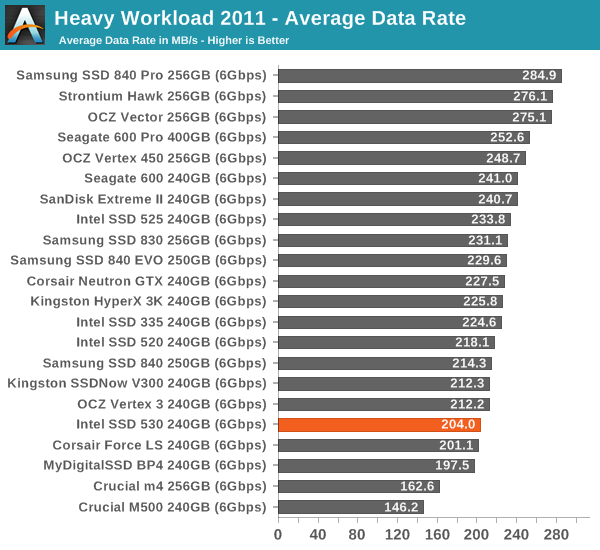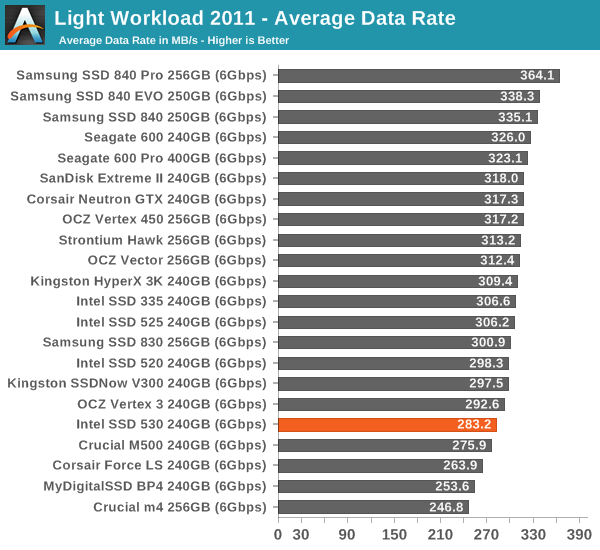Intel SSD 530 (240GB) Review
by Kristian Vättö on November 15, 2013 1:45 PM EST- Posted in
- Storage
- SSDs
- Intel
- Intel SSD 530
AnandTech Storage Bench 2011
Two years ago we introduced our AnandTech Storage Bench, a suite of benchmarks that took traces of real OS/application usage and played them back in a repeatable manner. Anand assembled the traces out of frustration with the majority of what we have today in terms of SSD benchmarks.
Although the AnandTech Storage Bench tests did a good job of characterizing SSD performance, they weren't stressful enough. All of the tests performed less than 10GB of reads/writes and typically involved only 4GB of writes specifically. That's not even enough exceed the spare area on most SSDs. Most canned SSD benchmarks don't even come close to writing a single gigabyte of data, but that doesn't mean that simply writing 4GB is acceptable.
Originally I kept the benchmarks short enough that they wouldn't be a burden to run (~30 minutes) but long enough that they were representative of what a power user might do with their system.
Not too long ago I tweeted that I had created what I referred to as the Mother of All SSD Benchmarks (MOASB). Rather than only writing 4GB of data to the drive, this benchmark writes 106.32GB. It's the load you'd put on a drive after nearly two weeks of constant usage. And it takes a *long* time to run.
1) The MOASB, officially called AnandTech Storage Bench 2011 - Heavy Workload, mainly focuses on the times when your I/O activity is the highest. There is a lot of downloading and application installing that happens during the course of this test. My thinking was that it's during application installs, file copies, downloading and multitasking with all of this that you can really notice performance differences between drives.
2) I tried to cover as many bases as possible with the software I incorporated into this test. There's a lot of photo editing in Photoshop, HTML editing in Dreamweaver, web browsing, game playing/level loading (Starcraft II & WoW are both a part of the test) as well as general use stuff (application installing, virus scanning). I included a large amount of email downloading, document creation and editing as well. To top it all off I even use Visual Studio 2008 to build Chromium during the test.
The test has 2,168,893 read operations and 1,783,447 write operations. The IO breakdown is as follows:
| AnandTech Storage Bench 2011 - Heavy Workload IO Breakdown | ||||
| IO Size | % of Total | |||
| 4KB | 28% | |||
| 16KB | 10% | |||
| 32KB | 10% | |||
| 64KB | 4% | |||
Only 42% of all operations are sequential, the rest range from pseudo to fully random (with most falling in the pseudo-random category). Average queue depth is 4.625 IOs, with 59% of operations taking place in an IO queue of 1.
Many of you have asked for a better way to really characterize performance. Simply looking at IOPS doesn't really say much. As a result I'm going to be presenting Storage Bench 2011 data in a slightly different way. We'll have performance represented as Average MB/s, with higher numbers being better. At the same time I'll be reporting how long the SSD was busy while running this test. These disk busy graphs will show you exactly how much time was shaved off by using a faster drive vs. a slower one during the course of this test. Finally, I will also break out performance into reads, writes and combined. The reason I do this is to help balance out the fact that this test is unusually write intensive, which can often hide the benefits of a drive with good read performance.
There's also a new light workload for 2011. This is a far more reasonable, typical every day use case benchmark. Lots of web browsing, photo editing (but with a greater focus on photo consumption), video playback as well as some application installs and gaming. This test isn't nearly as write intensive as the MOASB but it's still multiple times more write intensive than what we were running in 2010.
As always I don't believe that these two benchmarks alone are enough to characterize the performance of a drive, but hopefully along with the rest of our tests they will help provide a better idea.
The testbed for Storage Bench 2011 has changed as well. We're now using a Sandy Bridge platform with full 6Gbps support for these tests.
AnandTech Storage Bench 2011 - Heavy Workload
We'll start out by looking at average data rate throughout our new heavy workload test:

Performance in our 2011 Storage Bench is a bit below the average of SF-2281, although the difference isn't anything to worry about. I decided to include only the most important graphs but you can find the complete dataset in our Bench.
AnandTech Storage Bench 2011 - Light Workload
Our light workload actually has more write operations than read operations. The split is as follows: 372,630 reads and 459,709 writes. The relatively close read/write ratio does better mimic a typical light workload (although even lighter workloads would be far more read centric).
The I/O breakdown is similar to the heavy workload at small IOs, however you'll notice that there are far fewer large IO transfers:
| AnandTech Storage Bench 2011 - Light Workload IO Breakdown | ||||
| IO Size | % of Total | |||
| 4KB | 27% | |||
| 16KB | 8% | |||
| 32KB | 6% | |||
| 64KB | 5% | |||











60 Comments
View All Comments
AnnonymousCoward - Monday, November 18, 2013 - link
I enjoyed the review, but why can't you have a single real world benchmark??? You compare CPUs based on the time it takes to encode/decode, and fps in games. That tells readers the quantified difference. Your SSD data tells the reader nothing about Windows startup time, file copy time, and program load time. This has been an overlook on Anandtech from Day 1. I've brought this up multiple times in these comments, but you guys somehow don't get it.dhisumdhisum - Tuesday, November 19, 2013 - link
Debroah, will you marry me? I don't work, I am a bum.dac7nco - Tuesday, November 19, 2013 - link
Greatest reply ever.Bullwinkle J Moose - Saturday, November 23, 2013 - link
Technically, that was a proposal...The reply has not yet been given
Tjalve - Wednesday, November 20, 2013 - link
I have actually don that kind of testing. But i use 20min idle time.http://www.nordichardware.se/SSD-Recensioner/svens...
The text is in swedish so use google translate to translate to english. But scroll down and qlik on the links.
But check the diffrence between test 6 and 7 in the graphs.
Tjalve - Wednesday, November 20, 2013 - link
I have actually don that kind of testing. But i use 20min idle time.http://www.nordichardware.se/SSD-Recensioner/svens...
The text is in swedish so use google translate to translate to english. But scroll down and qlik on the links.
But check the diffrence between test 6 and 7 in the graphs.
nicolaim - Wednesday, November 27, 2013 - link
MyDigitalSSD sells M.2 SSDs at retail, so saying M.2 SSDs are OEM-only is incorrect.mi1stormilst - Friday, December 6, 2013 - link
The Intel 530 is $169.99 on newegg today ... tack on the 10% discount code floating around (NAFSAVETENDEC6W) for newegg and you have a bargain at $155.98 shipped!!!PKR - Sunday, December 8, 2013 - link
With my Macbook pro Mid 2010, and Intel 530 240gb with DC12 firmware, I think this ssd is slow - I am only getting about 200 mbps write and 260 mbps read speed. Very disappointed, as I the reviews online pointed to speeds in the range of 500 mbps.I tried the installation two ways - one by cloning the system partition using carbon copy cloner, and another using a fresh install from super-drive and updating .. In both cases, speed didn't change.
If it matters, I have 4 partitions on the drive. The system partition is of size 100gb, with about 40gb free space after migrating my content.
Wolfpup - Monday, December 16, 2013 - link
I switched from Intel to Micron/Crucial after Intel switched to Sandforce controllers...I'd still pick this over OTHER sandforce drives, but I'm still picking an M500 over this...